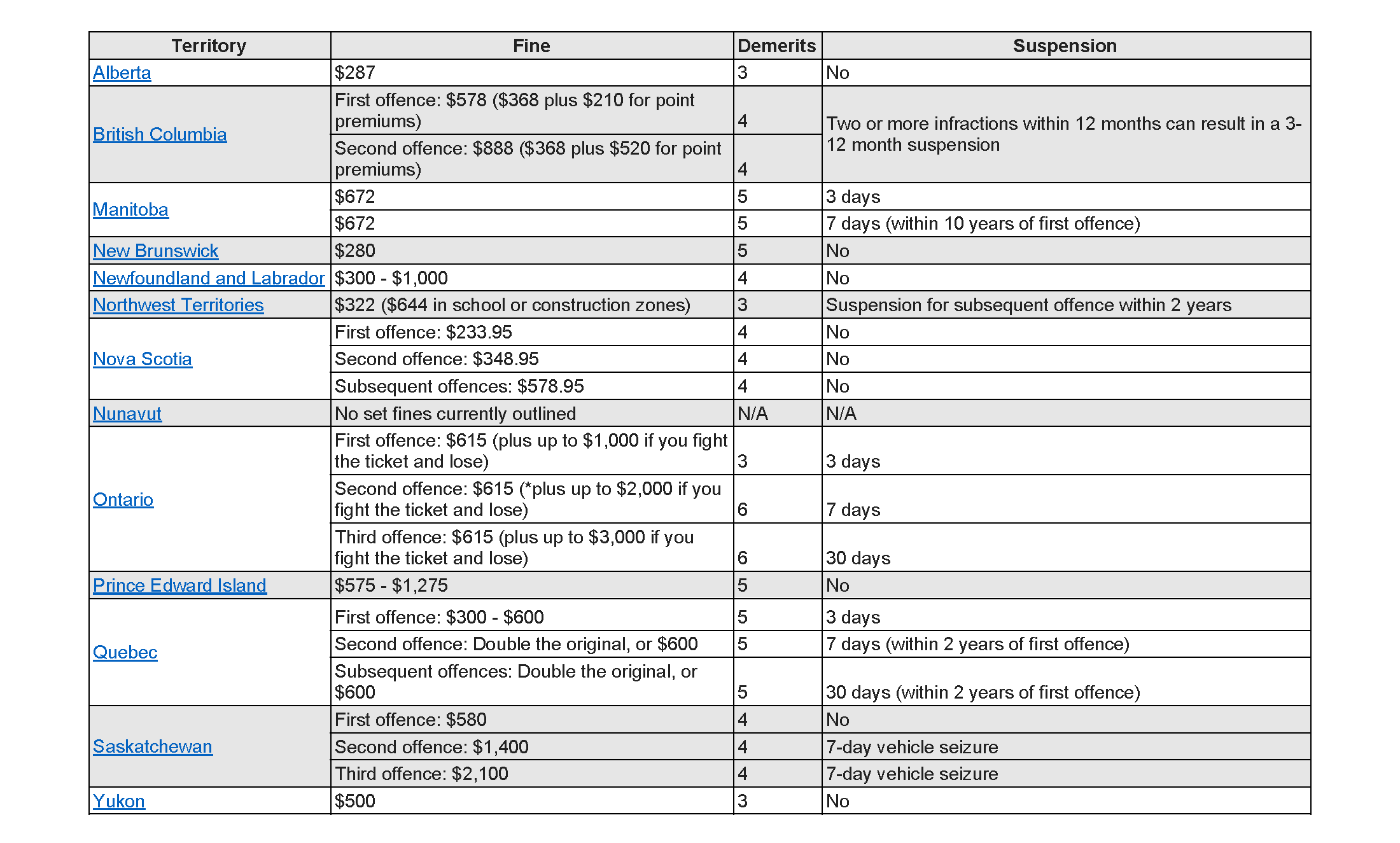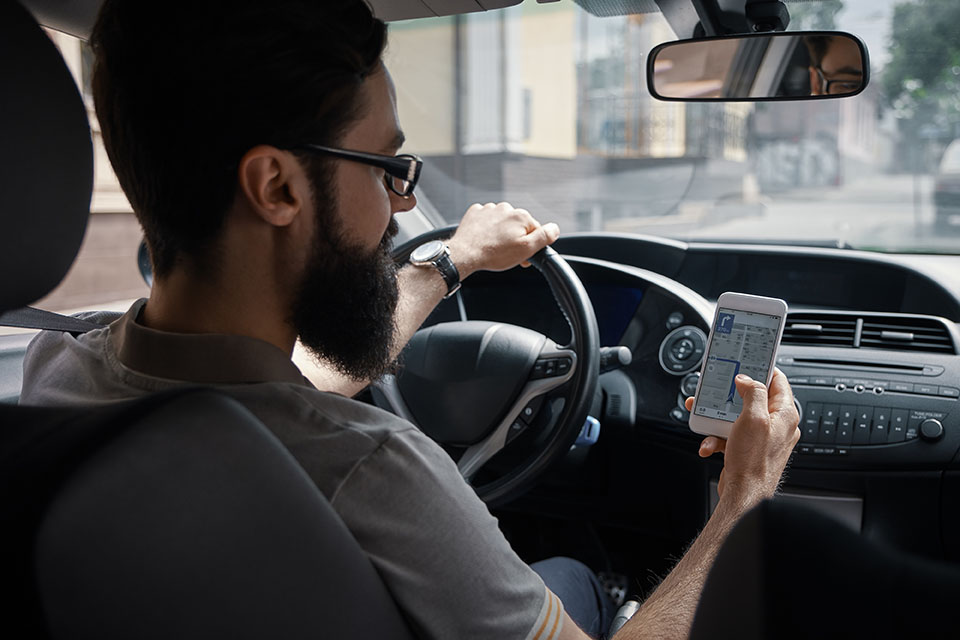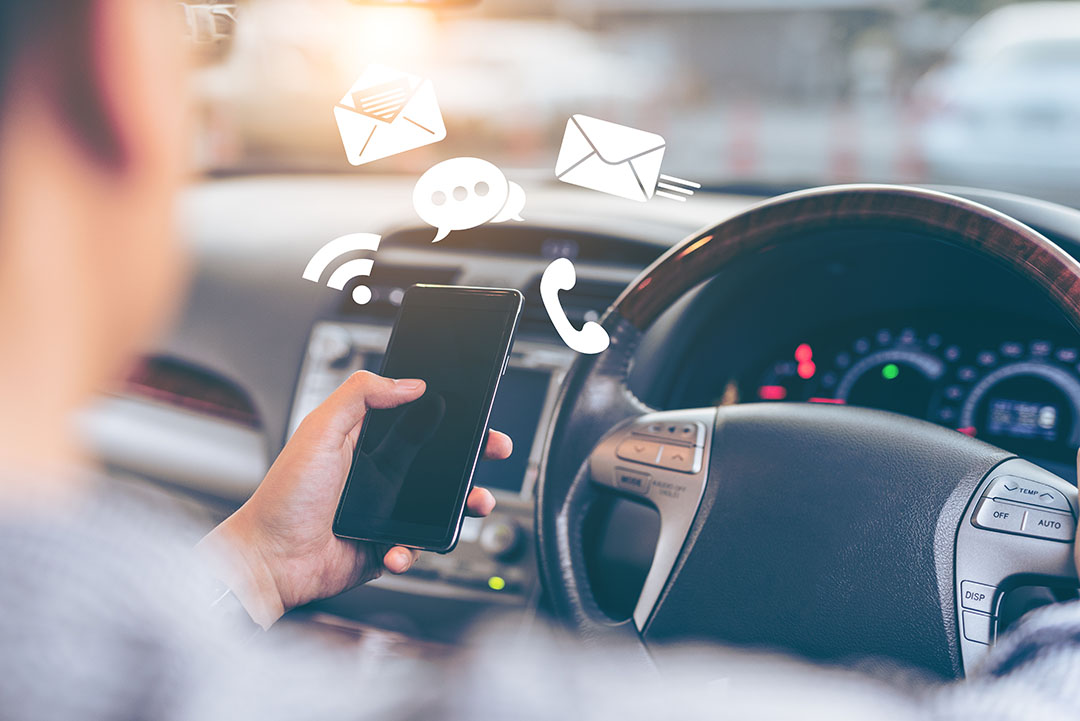In the last two years, nearly all provinces and territories in Canada have updated their distracted driving laws, with many of them more than doubling their previous fines.
While it is safe to say that everyone recognizes the dangers of drunk driving, distracted driving is often brushed off as being far less serious. However, the reality is that in some parts of Canada, distracted driving has actually become more dangerous.
Here are some things you need to know about distracted driving plus 10 things you can do to help keep yourself and other drivers safe.
Understanding Distracted Driving

The Canadian Council of Motor Transport Administrators defines distracted driving as “[occurring] when the driver’s attention is drawn to some other activity or event inside or outside of the vehicle rather than focusing on the driving task.”
The most common culprit of distracted driving is reading or replying to text messages on a cell phone, but distractions can include anything from changing the radio or adjusting climate controls to checking a GPS.
Perhaps unsurprisingly, there is quite a gap in how Canadians see their own behavior and how dangerous that behavior can be. A survey from InsuranceHotline.com found that 26% of respondents admitted to checking messages while driving, but 75% said they felt unsafe as a passenger when the driver was using their phone.
Feeling unsafe as a passenger when your driver is on the phone is an extremely valid concern. The Federal Motor Carrier Safety Administration conducted two extensive studies on distracted driving of varying degrees. Among the results, the studies found that texting requires you to take your eyes off the road for an average of 4.6 seconds.
When you consider the fact that, at 90 kph you travel 25 meters in one second, you would travel the length of almost two hockey rinks while reading a text message.
Distracted Driving Penalties in Canada
Across Canada, the fines for distracted driving range from under $200 to over $2,000, with varying license suspensions accompanying the fines. It is important that you familiarize yourself with the applicable penalties in your jurisdiction.
The chart below includes the newest penalty updates, which went into effect in Saskatchewan on February 1, 2020.

Want to view more online safety training content?
VIEW THE 800+ COURSES AVAILABLE!
10 Ways to Prevent Distracted Driving
1. Store loose items that could fall
While cell phones are a major cause of distraction to drivers, many other items inside a vehicle can be equally distracting. You should always secure loose items before departing, for more than one reason.
If items inside your vehicle, such as a phone, bag or water bottle, fall over when you are driving, you may be inclined to reach for them. However, this not only takes your focus off the road but can cause you to jerk the steering wheel or accidentally step on the gas or brake pedal, creating hazards for other drivers.
One other danger to consider is, if you do get into a collision, any loose items instantly become dangerous projectiles. Whenever possible, you should store items in an enclosed trunk and make sure open items in your vehicle are tightly closed so that if they do fall over, it will be okay to not be immediately picked up.
2. Adjust all in-car settings before starting your drive
When learning to drive, you learn that the first steps are to buckle your seatbelt and adjust all the in-car settings, such as side and rear view mirrors, seat positions and even climate controls. As you become a more experienced driver, you likely start adjusting these settings once you’re already driving.
However, all of these tasks require you to take your eyes off the road, so you should be sure and adjust your comfort settings when you first get in the car.
One additional tip to remember is that being too warm can make you become tired more easily, leading to drowsy and dangerous driving. Keep the temperature inside your car cool to help you stay awake and alert.
3. Pre-set your GPS

Whether on a short daily commute or heading out on a longer road trip, for work or for fun, many people rely on GPS. In fact, one study found that more than three-fourths of smartphone owners regularly use navigation apps.
Planning your route ahead of time is smart, but people commonly use a GPS app on the road, glancing down for step-by-step directions or even entering a destination.
If you must use a GPS app in the car, it is highly recommended that you turn on audio directions. This allows you to keep your eyes on the road and still receive directions or route updates, keeping you and your fellow drivers safe.
4. Create a driving playlist
A common but often overlooked reason people get distracted is adjusting what they are listening to. You may argue that skipping a song takes only a fraction of a second, but remember that a serious accident can also occur in that same short time.
Before heading out on the road, whether on your daily commute or for a long road trip, you should have your music preferences ready.
Many cars have radio controls on the steering wheel, making it easy to switch preset radio stations, or you can use your phone’s music app to create a custom playlist of only songs you enjoy before hitting the road. Spotify now even offers a feature – created specifically to combat distracted driving – to both free and premium accounts that automatically plays podcasts based on your preferences.
5. Don’t multitask

Many people like to believe they are good at multitasking, but that is categorically inaccurate. It is possible to multitask with simple, routine tasks, such as folding laundry while listening to a podcast, but once the tasks require more brain power, our ability to multitask fails.
Though we may not realize it, as it is so routine for most people, but driving a vehicle requires quite a bit of mental engagement. You need to be aware of how you are driving and also pay attention to drivers and hazards around you.
Now think about adding the focus needed for eating (to make sure you don’t spill) or even grooming (to get your hair or makeup just right) on top of that, and it becomes easy to see why multitasking while driving is ill-advised and even illegal.
However tempting it may be to try and complete these tasks during your commute, be sure to give yourself enough time to get everything done that you need before leaving the house. If you are running late for work, it is better to notify your supervisor (before you start driving, of course) than it is to risk your safety and the safety of other drivers.
6. Have your passenger respond
You have probably heard of having a designated driver but what about a designated texter? Of course this will not be applicable every time you hit the road, but it is good to keep in mind when there is more than one person in the car, whether you are the driver or a passenger.
If you are driving with co-workers, you can inform your boss ahead of time that you will be driving and that they can contact your passenger should an emergency arise. You can implement the same type of system for non-work drives as well. Simply let a passenger reply to texts or answer phone calls if something urgent comes up.
A passenger can also be in charge of controlling the music and providing directions using the GPS. Anything a passenger can do to take tasks away from the driver will help everyone on the road be safer.
7. Pull off the road if there is an emergency
Of course, you should not use your phone at all while driving, but sometimes situations arise that must be immediately addressed.
If you receive or need to make an emergency phone call or text, you should get off the road and park the vehicle where it is safe to do so. Once the car is stopped and out of the way of other vehicles, you may call or text as needed.

Another reason you should pull off the road is if you find yourself becoming excessively drowsy. Even though driving tired is something we all do, and there are no specific laws against it, this can be just as dangerous as distracted driving.
Being tired affects your ability to focus and can significantly reduce your reaction times. If you find yourself yawning or having trouble keeping your eyes open, pull over to a rest stop or other safe place to take a break, stretch your legs, get some coffee or even take a quick nap.
8. Use a Do Not Disturb setting
In recent years, cell phone manufacturers and mobile app creators have made it easier than ever to limit distractions in the car.
Apple created a mode called Do Not Disturb While Driving, first introduced with iOS 11. When activated, your iPhone will recognize when you are in a moving vehicle and automatically stop phone calls, texts and other notifications.
Google implemented a similar Do Not Disturb feature starting with the Pixel 2, which you can set to turn on when driving. Other Android users are also in luck, with the advent of numerous app options that function the same way. Driving Detective seems to be the most popular and was actually created using Google’s algorithm.
Similarly, all types of smartwatches come with a Do Not Disturb feature that can be quickly activated, often with one touch. No matter the type of mobile technology you are using, it is easy to limit the notifications you receive while driving.
9. Consider a company policy
Many people feel pressured to check calls or texts because they believe it could be work trying to get in contact with them. In fact, the 2019 Travelers Risk Index from Travelers Insurance found that 1 in 5 employees were concerned their boss would be upset if they did not answer a call, even if they were driving.
In order to ease your employees’ minds, your company should consider implementing a distracted driving policy, especially if you employ people who drive as part of their duties. Beyond just creating an official policy, you need to ensure managers and supervisors lead by example. Make sure all employees understand that no business is more important than their safety.
Most Do Not Disturb While Driving functions actually include a feature that allow people to get through for emergencies (for instance, two calls in a row or texting the word “urgent”). Your policy should explain that, if an employee is reached with an emergency, they need to safely pull off the road and park before calling or texting back.
10. Turn off your phone
While this seems like the most obvious solution to combat distracted driving, it is probably the most difficult to carry out. There have been numerous studies over the years showing our reliance, however subconsciously, on cell phones.
Essentially, we have been trained to respond to the pings and buzzes on our phones. Our brains get a hit of dopamine (the main chemical responsible for motivating behavior) and we then get an immediate reward after viewing or responding to the notification.
When our brains are in that elevated dopamine state, access to the prefrontal cortex, where judgment and reasoning occurs, shuts down, making it extremely difficult to say “no” to the cell phone ping.
However difficult it may be to feel like we will miss out on something, being out of immediate contact is very rarely a life-or-death situation; distracted driving often actually is. In 2016, distracted drivers were involved in nearly 20% of motor vehicle fatalities across Canada. Turning your phone off, and being unavailable for a few minutes or even a few hours, could literally save lives.
Start Driving Safer Today
Though the specific penalties vary, every Canadian jurisdiction has made it illegal to use cell phones and other hand-held devices while driving, illustrating how seriously the Canadian government takes this dangerous and all-too-common activity.
Because distracted driving affects nearly everyone, not just those who drive as part of their job, it is important for all employees to receive training on recognizing common distractions and how to minimize or eliminate them.
See how SafetySkills makes it easy to complete safety training on a variety of topics, including distracted driving, no matter your industry, job title or location.


